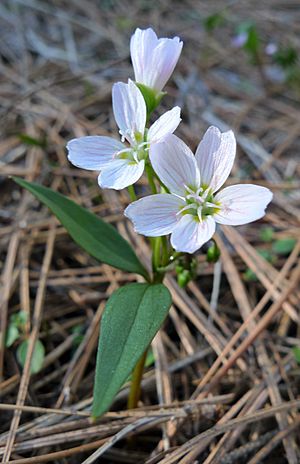Lanceleaf springbeauty facts for kids
Quick facts for kids Lanceleaf springbeauty |
|
|---|---|
 |
|
| Scientific classification | |
| Genus: |
Claytonia
|
| Species: |
lanceolata
|
Claytonia lanceolata is a lovely wild plant. It's often called the lanceleaf springbeauty or western springbeauty. This plant is part of the Montiaceae family.
Contents
Where This Plant Grows
This plant grows naturally in western North America. You can find it as far south as New Mexico. It lives in foothills and even high up on mountains, in places called alpine slopes. It likes rocky soil where the snow might never completely melt.
How It Grows
Claytonia lanceolata is a perennial plant. This means it lives for more than two years. It's also a herb, which means it has soft stems, not woody ones like a tree. It grows from a round, potato-like part called a tuber. This tuber is usually one to three centimeters wide.
The plant sends up a short, straight stem. It can grow up to 15 centimeters tall. When it's very small, it has just two round leaves before it flowers and then dies back. Its thick leaves are good for storing water. If the plant keeps growing, it will make thick, lance-shaped leaves higher up on the stem.
Flowers and Seeds
The flowers of Claytonia lanceolata are shaped like stars. They grow in groups called inflorescences. Each group can have three to 15 blooms. The flowers are usually white or pink. They often have thin, colored stripes and yellow spots near the bottom of each petal.
After the flowers, the plant makes a small fruit. This fruit is a tiny capsule. Inside, it holds two seeds. These seeds are black and shiny.
Plant Family Changes
For a long time, the Claytonia genus was part of the purslane family (Portulacaceae). But in 2009, scientists moved it. Now, it belongs to the Montiaceae family. This change happened when a new way of classifying plants, called the APG III system, was adopted.
What This Plant Is Used For
The entire Claytonia lanceolata plant can be eaten. You can eat it raw or cooked. This includes the potato-like corm (the tuber) that it grows from.
Native American peoples have used this plant for food for a long time. They ate the roots and the pods. These parts could be cooked and eaten like small potatoes. The leaves of the plant can also be eaten raw or cooked.
The Okanogan-Colville, Okanogan, and Thompson Native American peoples used the tuber of this plant. They ate it themselves and also used it to feed their animals.

